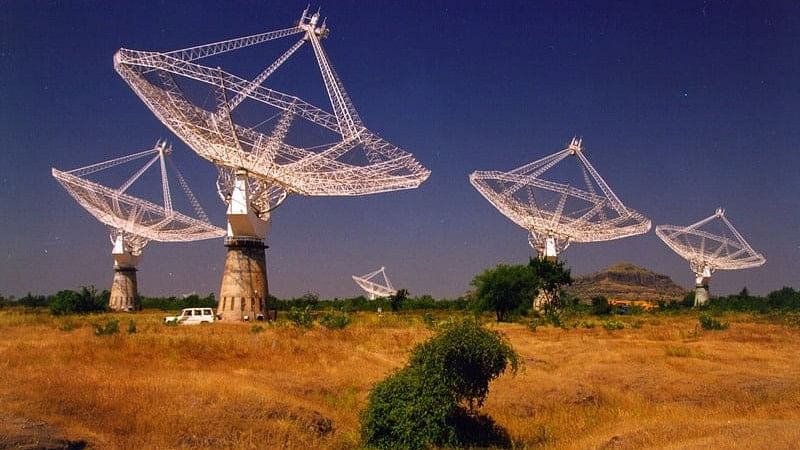
Earlier research has shown that galaxy-clusters may have been formed by mergers of smaller collections of galaxies. As a result they produce peripheral shocks which can be detected in radio waves as radio relics.
Credit: Giant Metrewave Radio Telescope NCRA - TIFR
New Delhi: As a part of a sky survey to map poorly-studied low-mass galaxy clusters, Indian astronomers have made a rare discovery of a “double radio-relic” or two radio wave emitting structures at the periphery of one single such galaxy-cluster.
So far only 12 such double relic structures are known to scientists, who believe that the discovery will provide crucial insights into the formation and evolution of galaxy-clusters.
A galaxy cluster is a structure that consists of anywhere from hundreds to thousands of galaxies bound together by the force of gravity. They are the largest objects in the universe and provide the closest picture of how the universe behaves.
“This study helps understand the dynamical evolution of galaxy clusters in much detail,” team leader Surajit Paul at Manipal Academy of Higher Education told DH.
Earlier research has shown that galaxy-clusters may have been formed by mergers of smaller collections of galaxies. As a result they produce peripheral shocks which can be detected in radio waves as radio relics.
Usually, there should be more than one such relic, preferably two. The observations, however, show binary systems are rare with scientists having no clue why it is so.
Galaxy-clusters have been widely studied for the search of dark matter. Initially not much attention was paid on low-mass clusters assuming they were not so active and were not radio-emitters.
But subsequent discovery of radio-wave emitters in a few low-mass clusters opened up a new window in astronomy.
This is something the Indian group has been exploring as they are surveying the sky with upgraded Giant Metrewave Radio Telescope near Pune – one of the world’s most sensitive radio telescopes - looking for low-mass galaxy clusters.
The team led by Paul has mapped 15 such clusters and noted another 10 after painstakingly observing very faint radio signals for months. The exercise known as GLOMACS (GMRT LOw MAss Cluster Survey) seeks to map 100 such galaxy clusters over the next five years.
Abell 2108 is one such low-mass cluster, which is 1.2 billion light-years away from the earth and was formed 12.5 billion years ago. It was initially identified to host a radio relic in its southern region, but then the Indian group found a second one in the north.
“We have now found another patchy and faint radio structure in the north of the cluster, revealing it as a rare double radio relic system,” said Swarna Chatterjee, a PhD student at Indian Institute of Technology, Indore and first author of the study.
The newly detected structure is twice the size of the southern relic and is one of the faintest radio relics detected so far. A comparison between the two shock waves – something akin to the wave that one can see when a stone is thrown in a water body – reveals the two are distinctly different.
The team comprising Paul, Chatterjee, Abhirup Datta from IIT Indore, Majidul Rahaman from the National Tsing Hua University, Taiwan and Ruta Kale from the National Centre for Radio Astrophysics, Pune also provides a possible explanation of how such extremely faint radio signals have been activated after remaining dormant for billions of years, thanks to the presence of what they call “fossil electrons.”
“The study of Abell 2108 shows a new mechanism to generate faint radio-signals from low-mass galaxy clusters. With deeper observations, many of the clusters may be detected with double relics as the sensitivity of radio telescopes improves and may in the future help resolve the issue of mismatch between the simulated prediction and the observations,” Paul said.
